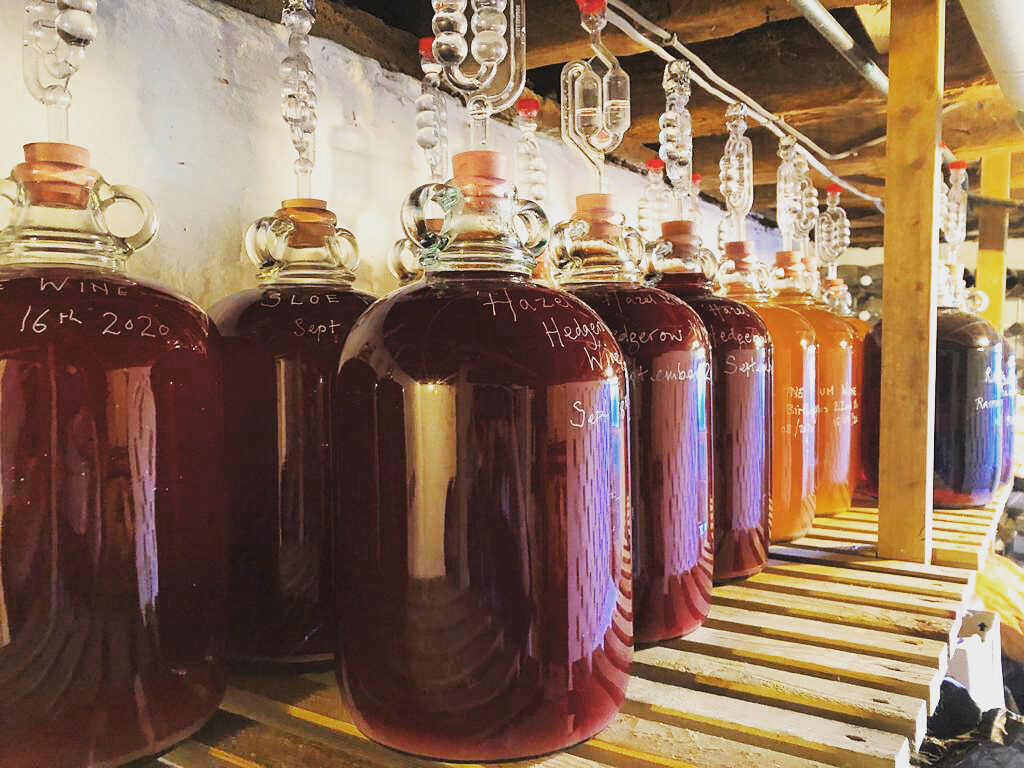Hedgerow Wine Recipe: Makes 1 demijohn = 6 x 750ml bottles
Ingredients:
1.5kg mixed hedgerow fruit – blackberries, sloes, haws
1.25kg sugar
4.5L boiling water
4 teabags (black tea)
*1 tsp pectolase
*1 tsp citric acid
*1 tsp yeast nutrient
*1 tsp wine yeast
*1 camden tablet (sulphite – optional)
Other equipment:
*Steriliser (e.g. Brew Safe or Milton)
*Fermenting vessel (a lidded plastic bucket will do)
*1 gallon demijohn with bung and airlock
Funnel
Muslin or similar as filter
*Siphon tube
6 used wine bottles
*All the above equipment can be cheaply bought online (try ‘Youngs’ for brewing supplies).
Method:
Day 1
Gather fruit. You can freeze it until you have enough.
Sterilise fermentation vessel according to steriliser instructions. Scrupulous cleanliness is the secret to good wine.
Put fruit and sugar into fermentation vessel.
Boil water and add teabags (for tannin)
Remove teabags and pour boiling water onto fruit/sugar in fermentation vessel. Stir until sugar is dissolved. Leave to cool.
Day 2
Add 1tsp Pectolase (pectin destroying enzyme) and stir and cover. Pectolase destroys the pectin that can make wine cloudy, hence giving you a clear wine at the end of fermentation.
Day 3
Add 1tsp citric acid. Stir.
Add 1tsp yeast nutrient. Stir.
Add 1tsp wine yeast. Stir and cover.
Days 4, 5 & 6
Stir and cover. The brew should start to bubble and ferment over this time. Stirring oxygenates the ferment and breaks down any moulds that might creep in otherwise. It may look a little murky and not even smell very nice, but have faith…trust the process.
Day 7
Don’t stir so that any sediment is settled.
Sterilise a demijohn, bung, airlock, funnel and maybe a bit of muslin to filter out excess sediment.
Transfer the brew from the fermentation vessel to the demijohn using a jug, siphon or tap if the fermentation vessel has one. Fill the demijohn as high as possible, leaving room for the bung to go in without touching the liquid.
Optional – add 1 camden tablet (sulphite) to ensure that your wine doesn’t ‘spoil’ during fermentation. If you are scrupulously hygenic you don’t have to do this.
Fit the bung into the top of the demijohn with an airlock. Pour some water into the airlock. Your demijohn is now airtight and no vinegar yeasts or other nasties can enter the wine during the next process of fermentation.
Label the demijohn with date and fruit.
Fermentation
Leave the demijohn to continue fermentation undisturbed for a month or so, until all bubbling has completely stopped.
Racking off or bottling
Your wine is ready to drink ‘young’ as soon as the fermentation process (bubbling) has stopped.
You can rack it off (transfer it) to another sterilised demijohn at this stage using a siphon which leaves the leys (any sediment) in the first demijohn, or if you’re impatient to try it, like me, you can transfer it straight into sterilised wine bottles which you can seal with cork (using a corker which you can buy online) or screw tops. It’s best to stand the bottles upright if you use screw tops to avoid dripping.
The wine continues to mature and change in flavour once it is bottled.
Try this recipe with any other ingredients you have to hand. Experiment and have fun.

ENJOY!

No responses yet